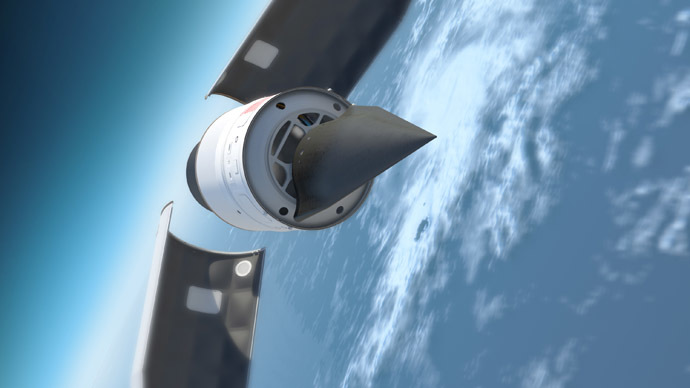
US weapons researchers are looking to develop missiles moving more than five times the speed of sound, with arms giant Raytheon getting the initial $20 million development contract. The first flight tests are expected within two to four years.
Existing ballistic missiles reach hypersonic speeds during the final stages of their flight, but are unable to change their trajectory, making them vulnerable to missile defense systems. An operational hypersonic missile could maneuver to evade counter-fire, and strike distant targets with great precision.
The $20 million contract from Defense Advanced Research Projects Agency (DARPA) amounts to a feasibility study, noted Amy Woolf, a nuclear weapons policy specialist at the Congressional Research Service. Getting the theory to work would be a major breakthrough for both Raytheon and the US military. “The problem is we have yet to get a boost glide system to work,” Woolf told the Boston Globe.
DARPA has been working on hypersonic missiles for years, testing one in 2011. It now appears those tests were not as successful as was claimed at the time, and the agency is enlisting Raytheon to go back to the drawing board.
Raytheon executives seemed optimistic about their prospects. “We’re on a fast track to deliver these hypersonic solutions,” Dave Scott, the company’s vice-president of Advanced Missile Systems Business Development, said in a press release.
“It’s no longer science fiction,” added Chris Toal, technical lead for Advanced Air and Missile Defense. “It could soon be science fact.”
To qualify as “hypersonic” by US standards, a missile has to be capable of exceeding the speed of sound by at least five times (Mach 5). Previous attempts at hypersonic flight focused on a “scramjet” engine.
Raytheon’s proposal is exploring a different possibility, called the “Tactical Boost Glide” system. The TBG missile would be launched from a conventional aircraft and rocket into the outer layer of Earth’s atmosphere at hypersonic speeds, gliding along the surface of the atmosphere before plummeting down onto the target. The key feature of the missile would be the operators’ ability to alter its course during that final phase.
According to the Stockholm International Peace Research Institute data from 2013, Raytheon was the fourth-largest arms manufacturer in the world, with 93 percent of their $23,7 billion sales coming from weapons.
Earlier this month, the Chinese People’s Liberation Army tested a hypersonic missile they say is capable of reaching Mach 10. It was the fourth test of the missile, designated “WU-14” by the US military, in 18 months. Russian weapons manufacturers have said they hoped to have a hypersonic missile operational by 2030.
RELATED ARTICLES
- UK Warns that China is Preparing for Total Nuclear War with the West
- Russia & China Plan Building Nuclear Power Plant on the Moon
- China expands Social Credit Score to include Central Bank Digital Currencies
- Chinese people angry after government announces Lockdowns for Common Flu
- Protests and riots intensify in China to escape Xi's Lockdown tyranny












They are about 30years behind the curve.
Russian ICBM’s can use evasive maneuvers even during the re-entry phase with their MIRV’s.
Whats next U.S. will announce that they have developed SAM’s capeble of the same as an S-300? Wich is again around 30+years old, while S400 is already in service as well with the S-500 already on the horizon with speeds of up to Mach 20.lol.